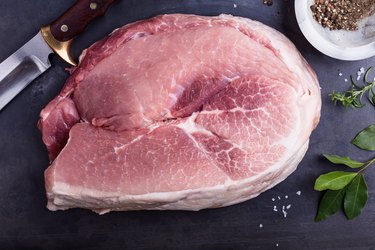
Cooking a ham in a roaster oven provides an entrée to feed a family or a house full of company. The leftovers can be used to make sandwiches or to flavor bean soup and other dishes.
Tip
To cook a precooked ham in an electric roaster, cut off most of the fat and prepare a glaze to apply twice during the cooking process. Bake at 325 degrees Fahrenheit for two hours or until the internal temperature reaches 145 F.
Video of the Day
Ham in Electric Roaster Recipe
Hamilton Beach provides a recipe for cooking a ham in its roaster ovens. The recipe is adapted here for use in any roaster oven:
Video of the Day
Ingredients:
- 15-pound fully cooked, smoked ham
- 1/2 cup orange juice
- 1/2 cup honey
- 1 cup brown sugar, packed
- 2 cups water
- Whole cloves
Instructions:
- Take the rack out of the roaster, and pour 2 cups of water into the insert pan.
- Put on the roaster cover and preheat to 325 F.
- Cut off most of the fat, leaving 1/4
inch.
- Score the remaining fat in a diamond design to help hold the glaze and place a whole clove in each diamond.
- Place the ham on the rack, and then put the rack in the roaster.
- Cover and bake for one hour.
- Mix the remaining ingredients to make the glaze.
- Remove the cover and drizzle half of the glaze on the ham. Replace the cover and bake an additional hour.
- Remove the cover again and apply the other half of the glaze to the ham.
- Replace the cover and bake for an additional 10 minutes.
- Check the internal temperature of the ham, which should be at least 145 F.
This recipe serves 15 to 20 people. Use any leftovers to make ham and Swiss cheese sliders. To prepare these, spread Hawaiian rolls with mayo and mustard; then top with ham and Swiss cheese before baking in a toaster oven.
How to Clean a Roaster
Nesco gives instructions on how to clean a roaster oven. After use, allow the roaster to cool, and then remove the cover, rack and insert pan. You may wash the removable parts in warm, soapy water, but never immerse the roaster in water.
If food is cooked on to the surfaces, remove it with a nonabrasive cleanser or pad. Don't use steel wool because it will scratch the finish.
An easier method of cleaning baked-on food involves placing the insert pan in the roaster and then filling the pan with hot water, says Nesco. Cover the roaster and heat to 350 F for 30 minutes. Turn off the heat and let the roaster cool completely. Afterward, clean as instructed above.
Finally, wipe the outside of the roaster with a damp cloth and then wipe dry. Don't put the roaster in water or use abrasive cleansers on its exterior.
Pork Safety Guidelines
Ham is a pork product, which can contain the parasite that causes trichinosis, reports the USDA Food Safety and Inspection Service. To avoid this food-borne illness, cook ham to an internal temperature of 145 F.
Pork and other meats may also contain Salmonella, Escherichia coli and Staphylococcus aureus bacteria. To protect yourself from these infections, never eat undercooked ham and take precautions to prevent cross-contamination of food surfaces such as cutting boards, countertops and utensils.
Never thaw a frozen ham at room temperature. Instead, thaw it in the refrigerator, in the microwave or in an airtight bag immersed in cold water. The safest method is to thaw it in the refrigerator.
Pork, along with red meats like beef and lamb, has been linked to a higher cancer risk, according to a study published in the February 2017 issue of Oncology Reviews. The World Cancer Research Fund recommends limiting consumption of these meats to no more than three servings per week, which means about 12 to 18 ounces total.